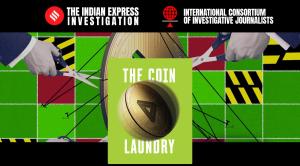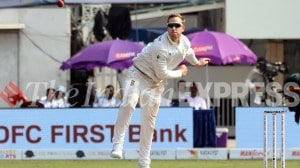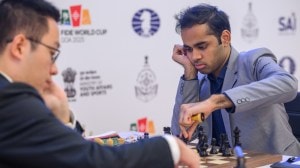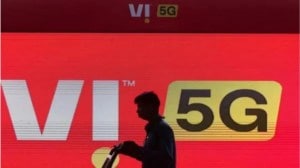Narayan Debnath, the cartoonist who never underestimated children
Narayan Debnath, like all great artists, managed to make most of his creations timeless. Which is ironic because for generations of Bengalis, a Narayan Debnath comic strip exudes nostalgia.
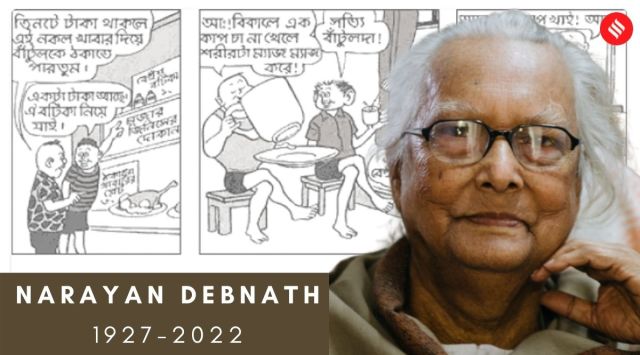 In the 1950s, Debnath the illustrator was made an offer that challenged him as an artist. He was asked to conceive a comic strip for Deb Shahitya Kutir. (Express photo)
In the 1950s, Debnath the illustrator was made an offer that challenged him as an artist. He was asked to conceive a comic strip for Deb Shahitya Kutir. (Express photo)Handa and Bhoda, two bungling Bengali teenagers, making an Instagram reel on Kolkata’s famous chicken kati roll (and later fighting over it)?
Baatul the Great, probably India’s first completely indigenous superhero, flexing for a gym selfie?
Why not.
Those who follow Bengali comics would probably have no issues with these appropriations. For Narayan Debnath, like all great artists, managed to make most of his creations timeless. Which is ironic because for generations of Bengalis, a Narayan Debnath comic strip exudes nostalgia.
About sixty years ago, when the Bengali children’s magazine Shuktara brought together some of the best minds of Bengal, cartoonist Narayan Debnath, who died in Kolkata on Tuesday morning, stood out.
Getting nostalgic- On Jan 31, 2021 when Smt. sudesh Dhankhar & myself went to enquire about health #NarayanDebnath at Belle Vue Clinic, the legend blessed us and instantly drew this masterpiece to be ever cherished by us. Pray Almighty to bestow eternal peace to the noble soul. https://t.co/ieOf4Y9Qzx pic.twitter.com/sc9YKS5rHH
— Governor West Bengal Jagdeep Dhankhar (@jdhankhar1) January 18, 2022
That Debnath, who was born to a family of goldsmiths in 1927, landed himself a job as an illustrator at the Deb Shahitya Kutir (one of the most popular publishing houses of Kolkata) in the late 1940s was no surprise to his family members. Debnath was into the arts from a very young age and his father encouraged him. He also ensured that Debnath went to the Indian Art College, a course not very coveted in middle class Bengali households of the era (or indeed, even today). A course that he discontinued in the fifth year.
In the 1950s, Debnath the illustrator was made an offer that challenged him as an artist. He was asked to conceive a comic strip for Deb Shahitya Kutir.
“I did not know what that entailed. I decided to fall back on my ability to observe things around me. The peculiarities of people around me. Their habits. Things that made them different, things that made them prototypes,” Debnath told The Indian Express in a 2013 interview.
His strip about the two bumbling boys called Handa and Bhoda attracted instant attention. “My characters were based on observations. I was talking about the boys of those times through these characters. The way they talked and dressed, everything was designed to make them more relevant to the young,” said Debnath.
As years passed, Handa and Bhoda kept pace with the times. “The trick is to never underestimate children,” said Debnath.
Felt energized when blessed by 96 year legend Padma Shri Narayan Debnath hospitalized at Belle Vue Clinic.
At mention of his cult Bengali comic character- Bantul the Great, legend cartoonist, graphic novelist instantly drew one with pen I had used to sign my oath as Governor. pic.twitter.com/dkibFcOPeZ
— Governor West Bengal Jagdeep Dhankhar (@jdhankhar1) January 31, 2021
That strategy obviously paid off. “No other cartoonist managed to get as much love as Narayan Debnath. His patrons doted on him,” says noted Bengali cartoonist, Debashish Deb, a self-confessed fan.
That his creations shaped the imagination of generations of Bengalis is evident from the way his Bantul the Great was used to boost the morale of Indians during the 1971 war with Pakistan. The publishers wanted Bantul to be the superhero India needed. Debnath obliged. Bantul could lift tanks, uproot buildings and change directions of canon shells.
“The most enduring quality of Narayan Debnath was his versatility. He could rustle up a range of feelings in his patrons with consummate ease,” says Debashish Deb.
His career may have spanned more than half-a-century, but Debnath was never preoccupied with “material success”. “He was immensely popular, he was always working. He worked well into his 90s, but that did not reflect in his bank balance,” says Deb. One suspects that bothered Debnath much. Till his could, he did what he liked doing-create experiences for generations of Bengalis.
📣 For more lifestyle news, follow us on Instagram | Twitter | Facebook and don’t miss out on the latest updates!





- 01
- 02
- 03
- 04
- 05








